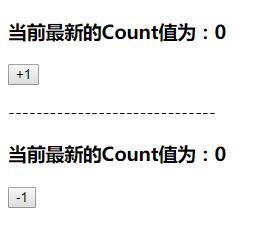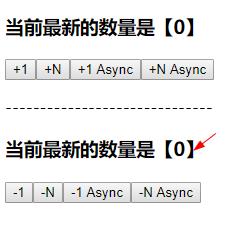1、安装vuex依赖包
npm install vuex --save
2、导入vuex包
import Vuex from 'vuex'
Vue.use(Vuex)
3、创建 store 对象
export default new Vuex.Store({ // state 中存放的就是全局共享的数据 state: { count: 0 } })
4、将 store 对象挂载到 vue 实例中
new Vue({ el: '#app', render: h => h(App), router, // 将创建的共享数据对象,挂载到 Vue 实例中 // 所有的组件,就可以直接用 store 中获取全局的数据了 store })
Vuex 是一个专为 Vue.js 应用程序开发的状态管理模式。它采用集中式存储管理应用的所有组件的状态,并以相应的规则保证状态以一种可预测的方式发生变化。
核心模块:State、Mutations、Actions、Module、Getters
在 components 目录下新建 Addition.vue 文件:
<template> <div> <h3>当前最新的Count值为:</h3> <button>+1</button> </div> </template>
Subtraction.vue 文件:
<template> <div> <h3>当前最新的Count值为:</h3> <button>-1</button> </div> </template>
打开 App.vue 文件,引入俩个组件:
<template> <div> <my-addition></my-addition> <p>------------------------------</p> <my-subtraction></my-subtraction> </div> </template> <script> import Addition from './components/Addition' import Subtraction from './components/Subtraction' export default { components: { 'my-addition': Addition, 'my-subtraction': Subtraction }, data () { return {} } } </script>
(1)、State:
// 创建store数据源,提供唯一公共数据 const store = new Vuex.Store({ state: { count: 0 } })
组件访问 Store 中数据的第一种方式:
this.$store.state.全局数据名称
组件访问 Store 中数据的第二种方式:
// 1.从 vuex 中按需导入 mapState 函数 import { mapState } from 'vuex'
通过刚才导入的 mapState 函数,将当前组件需要的全局数据,映射为当前组件的 computed 计算属性:
// 2.将全局数据,映射为当前组件的计算属性 computed: { ...mapState(['count']) }
打开 store/index.js 文件,定义 count:
import Vue from 'vue' import Vuex from 'vuex' Vue.use(Vuex) export default new Vuex.Store({ state: { count: 0 }, mutations: { }, actions: { }, modules: { } })
回到 Addition.vue 文件中,用第一种方式:
<template> <div> <h3>当前最新的Count值为:{{$store.state.count}}</h3> <button @click="handleAdd">+1</button> </div> </template>
回到 Subtraction.vue 文件中,用第二种方式:
<template> <div> <h3>当前最新的Count值为:{{count}}</h3> <button>-1</button> </div> </template> <script> import { mapState } from 'vuex' export default { data () { return {} }, // 计算属性 computed: { ...mapState(['count']) // 用...展开运算符把Count展开在资源属性里 } } </script>
此时效果图:

(2)、Mutations:
Mutations 用于变更 Store 中的数据。只有 mutation 里的函数才有权利去修改 state 中的数据。mutation 非常类似于事件:每个 mutation 都有一个字符串的 事件类型 (type) 和 一个 回调函数 (handler)。但是,mutation只允许同步函数,不能写异步的代码。
①只能通过 mutation 变更 Store 数据,不可以直接操作 Store 中的数据。
②通过这种方式虽然操作起来稍微繁琐一些,但是可以集中监控所有数据的变化。
定义:
// 定义 Mutation const store = new Vuex.Store({ state: { count: 0 }, mutations: { add (state) { // 变更状态 state.count++ } } })
第一种触发方式:
// 触发 mutation methods: { handleAdd () { // 触发 mutations 的第一种方式 this.$store.commit('add') } }
打开 store/index.js 文件,定义 mutations :
mutations: { add (state) { state.count++ } }
回到 Addition.vue 文件中触发:
<template> <div> <h3>当前最新的Count值为:{{$store.state.count}}</h3> <button @click="handleAdd">+1</button> </div> </template> <script> export default { methods: { handleAdd () { this.$store.commit('add') } } } </script>
此时点击+1按钮,就可以看到数值变为1。
还可以在触发 mutations 时传递参数:
// 定义 Mutation const store = new Vuex.Store({ state: { count: 0 }, mutations: { addN (state, step) { // 变更状态 state.count += step } } })
第一种触发方式:
// 触发 mutation methods: { handleAdd () { this.$store.commit('addN', 3) } }
打开 store/index.js 文件,增加一个 addN:
mutations: { add (state) { state.count++ }, addN (state, step) { state.count += step } }
回到 Addition.vue 文件中,增加一个+N的按钮并增加点击事件:
<template> <div> <h3>当前最新的Count值为:{{$store.state.count}}</h3> <button @click="handleAdd">+1</button> <button @click="handleAdd2">+N</button> </div> </template> <script> export default { data () { return { num: 2 } }, methods: { handleAdd () { this.$store.commit('add') }, handleAdd2 () { // commit 的作用,就是调用某个 mutation 函数 this.$store.commit('addN', this.num) } } } </script>
此时点击+N按钮就会每次增加2。
触发 mutations 的第二种方式:
// 1.从 vuex 中按需导入 mapMutations 函数 import { mapMutations } from 'vuex'
通过刚才导入的 mapMutations 函数,将需要的 mutations 函数,映射为当前组件的 methods 方法:
// 2.将指定的 mutations 函数,映射为当前组件的methods 函数: methods: { ...mapMutations({'add', 'addN'}) }
打开 store/index.js 文件,在 mutations 增加一个 sub:
mutations: { add (state) { state.count++ }, addN (state, step) { state.count += step }, sub (state) { state.count-- } },
回到 Subtraction.vue 文件中,给-1按钮增加点击事件:
<template> <div> <h3>当前最新的Count值为:{{count}}</h3> <button @click="handleSub">-1</button> </div> </template> <script> import { mapState, mapMutations } from 'vuex' export default { data () { return {} }, // 计算属性 computed: { ...mapState(['count']) // 用...展开运算符把Count展开在资源属性里 }, methods: { ...mapMutations(['sub']), handleSub () { this.sub() } } } </script>
这时刷新页面,点击-1按钮就会每次-1了。
打开 store/index.js 文件,增加一个 subN:
mutations: { add (state) { state.count++ }, addN (state, step) { state.count += step }, sub (state) { state.count-- }, subN (state, step) { state.count -= step } },
回到 Subtraction.vue 文件中,在增加一个-N的按钮,并添加点击事件:
<button @click="handleSub2">-N</button> <script> import { mapState, mapMutations } from 'vuex' export default { methods: { ...mapMutations(['sub', 'subN']), handleSub () { this.sub() }, handleSub2 () { this.subN(2) } } } </script>
这时点击-N按钮,每次就-2了。
下面有个需求,就是在点击+1按钮后延迟1秒在显示变化后的数值。
注意:不要在 mutations 函数中,执行异步操作。所以就需要用到了 Action 用于处理异步任务。
(3)、Actions:
Action 用于处理异步任务。
如果通过异步操作变更数据,必须通过 Action,但是在 Action 中还是要通过触发 Mutation 的方式间接变更数据。
定义:
// 定义 Action const store = new Vuex.Store({ // ...省略其他代码 mutations: { add (state) { state.count++ } }, actions: { addAsync (context) { setTimeout(() => { context.commit('add') }, 1000) } } })
第一种方式触发:
// 触发 Action methods: { handleAdd () { // 触发 actions 的第一种方式 this.$store.dispatch('addAsync') } }
打开 store/index.js 文件,增加一个 addAsync:
actions: { addAsync (context) { setTimeout(() => { // 在 actions 中,不能直接修改 state 中的数据 // 必须通过 context.commit() 触发某个 mutations 的函数才行 context.commit('add') }, 1000) } }
回到 Addition.vue 文件中,增加一个+1 Async的按钮并增加点击事件:
<button @click="handleAdd3">+1 Async</button> <script> export default { methods: { handleAdd () { this.$store.commit('add') }, handleAdd2 () { // commit 的作用,就是调用某个 mutation 函数 this.$store.commit('addN', this.num) }, handleAdd3 () { this.$store.dispatch('addAsync') } } } </script>
这时点击+1 Async按钮,可以实现延迟1秒后+1的功能了。
触发 actions 异步任务时携带参数:
定义:
// 定义 Action const store = new Vuex.Store({ // ...省略其他代码 mutations: { addN (state, step) { state.count += step }, }, actions: { addNAsync (context, step) { setTimeout(() => { context.commit('addN', step) }, 1000) } } })
触发:
// 触发 Action methods: { handleAdd () { // 在调用 dispatch 函数,触发 actions 时携带参数 this.$store.dispatch('addNAsync', 5) } }
打开 store/index.js 文件,增加一个 addNAsync:
actions: { addAsync (context) { setTimeout(() => { // 在 actions 中,不能直接修改 state 中的数据 // 必须通过 context.commit() 触发某个 mutations 的函数才行 context.commit('add') }, 1000) }, addNAsync (context, step) { setTimeout(() => { context.commit('addN', step) }, 1000) } }
回到 Addition.vue 文件中,增加一个+N Async的按钮并增加点击事件:
<button @click="handleAdd4">+N Async</button> <script> export default { methods: { handleAdd4 () { // 在调用 dispatch 函数,触发 actions 时携带参数 this.$store.dispatch('addNAsync', 5) } } } </script>
这时点击+N Async按钮,可以实现延迟1秒后+5的功能。
触发 actions 的第二种方式:
// 1.从 vuex 中按需导入 mapActions 函数 import { mapActions } from 'vuex'
通过刚才导入的 mapActions 函数,将需要的 actions 函数,映射为当前组件的 methods 方法:
// 2.将指定的 actions 函数,映射为当前组件的 methods 函数 methods: { ...mapActions(['addAsync', 'addNAsync']) }
打开 store/index.js 文件,在 actions 增加一个 subAsync:
actions: { addAsync (context) { setTimeout(() => { // 在 actions 中,不能直接修改 state 中的数据 // 必须通过 context.commit() 触发某个 mutations 的函数才行 context.commit('add') }, 1000) }, addNAsync (context, step) { setTimeout(() => { context.commit('addN', step) }, 1000) }, subAsync (context) { setTimeout(() => { context.commit('sub') }, 1000) } }
回到 Subtraction.vue 文件中,在增加一个-1 Async的按钮,并添加点击事件:
<button @click="handleSub3">-1 Async</button> <script> import { mapState, mapMutations, mapActions } from 'vuex' export default { methods: { ...mapMutations(['sub', 'subN']), ...mapActions(['subAsync']), handleSub () { this.sub() }, handleSub2 () { this.subN(2) }, handleSub3 () { this.subAsync() } } } </script>
还有个更简单的方式:
<button @click="subAsync">-1 Async</button> <script> import { mapState, mapMutations, mapActions } from 'vuex' export default { methods: { ...mapActions(['subAsync']) } } </script>
这样实现的效果是一样的。
下面用同样的思路来实现-N的异步操作:
打开 store/index.js 文件,增加一个 subNAsync:
actions: { subNAsync (context, step) { setTimeout(() => { context.commit('subN', step) }, 1000) } }
回到 Subtraction.vue 文件中,在增加一个-N Async的按钮:
<button @click="subNAsync(3)">-N Async</button> <script> import { mapState, mapMutations, mapActions } from 'vuex' export default { methods: { ...mapActions(['subAsync', 'subNAsync']) } } </script>
这时点击-N Async按钮,可以实现延迟1秒后-3的功能。
(4)、Getters:
Getter 用于对 Store 中的数据进行加工处理形成新的数据。不会修改 state 里的源数据,只起到一个包装器的作用,将 state 里的数据变一种形式然后返回出来。
① Getter 可以对 Store 中已有的数据加工处理之后形成新的数据,类似Vue的计算属性。
② Store 中数据发生变化,Getter 包装出来的数据也会跟着变化。
定义:
// 定义 Getter const store = new Vuex.Store({ state: { count: 0 }, getters: { showNum: state => { return '当前最新的数量是【'+ state.count +'】' } } })
使用 getters 的第一种方式:
this.$store.getters.名称
我们可以把文字的内容删除掉,然后用 getters 来替换:
打开 store/index.js 文件,定义getters:
getters: { showNum (state) { return '当前最新的数量是【' + state.count + '】' } }
回到 Addition.vue 文件修改:
<h3>{{$store.getters.showNum}}</h3>
此时刷新页面,已经变为了 getters 中的内容,效果图:

使用 getters 的第二种方式:
import { mapGetters } from 'vuex'
computed: {
...mapGetters(['showNum'])
}
打开 Subtraction.vue 文件修改:
<h3>{{showNum}}</h3> <script> import { mapState, mapMutations, mapActions, mapGetters } from 'vuex' export default { // 计算属性 computed: { ...mapState(['count']), // 用...展开运算符把Count展开在资源属性里 ...mapGetters(['showNum']) } } </script>
效果图:
